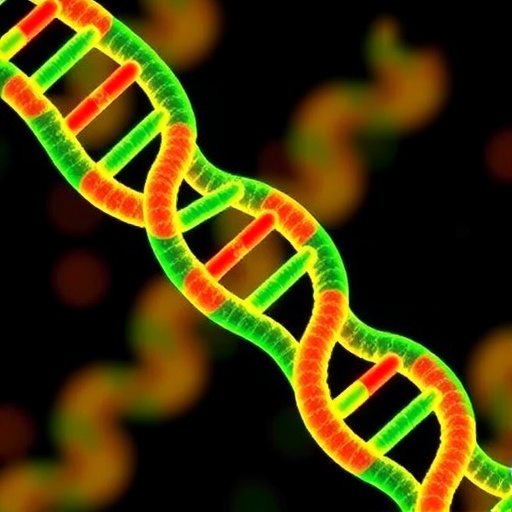
In a groundbreaking discovery that challenges long-held assumptions about how cells regulate genetic information, an international team of researchers has unveiled a novel “kinetic ruler” mechanism by which cells precisely determine the length of mRNA polyadenylate [poly(A)] tails. Contrary to the traditional belief that cells measure these tails based on their physical size, scientists now reveal that cells employ sophisticated timing mechanisms to control tail length with astonishing precision, akin to a molecular stopwatch.
Messenger RNA (mRNA) functions as the essential intermediary between DNA and protein synthesis, carrying genetic blueprints necessary for cellular function. Each mRNA molecule is terminated by a poly(A) tail — a chain of adenosine nucleotides that serves to both protect the mRNA from degradation and modulate its translational efficiency. In yeast, these tails consistently maintain a length of approximately 60 adenosines, yet the molecular basis for this remarkable consistency has remained elusive until this research.
The collaborative effort, spearheaded by the University of Turku in Finland and conducted alongside leading institutions including the Laboratory of Molecular Biology (LMB) in Cambridge, UK, and Aarhus University in Denmark, successfully reconstructed the tail-elongation process in vitro. The team identified two critical molecular actors in this process: the Cytoplasmic Polyadenylation Complex (CPAC), which polymerizes adenosines onto the mRNA, and Nab2, a nuclear poly(A)-binding protein that binds these tails and signals termination of elongation.
What sets this mechanism apart is the dynamic interplay between CPAC’s enzymatic speed in extending the adenosine chain and Nab2’s kinetic binding to the nascent tail. Rather than measuring tail length structurally, cells rely on a race between CPAC’s addition rate and Nab2’s association rate. When Nab2 molecules bind at a sufficient concentration and interval, specifically when two Nab2 proteins dimerize on the tail, they effectively halt further polymerization. This timing ensures that tail elongation consistently ceases between two and three seconds after initiation, guaranteeing uniform tail lengths across mRNA populations.
Dr. Matti Turtola, the study’s lead author and principal investigator at the University of Turku, articulates the elegance of this timing-based regulatory system. He states, “These molecular machines measure RNA not by size, but by timing. The precision comes from stopping the reaction always between two and three seconds after it begins.” This stopwatch-like metaphor underscores how cells employ kinetic parameters, rather than static measurements, to achieve molecular precision.
Moreover, the concentration of Nab2 within the cellular environment emerges as a potent determinant for tail length regulation since its abundance modulates the binding velocity. Remarkably, Nab2 also autoregulates its expression, thus maintaining the kinetic balance between tail extension and termination even as cellular conditions fluctuate. This self-tuning feedback loop exemplifies how intricate molecular systems preserve homeostasis under diverse physiological contexts.
The implications of this kinetic ruler go beyond yeast biology. mRNA polyadenylation critically influences the stability and translational efficiency of transcripts, directly affecting protein abundance and cellular function. By enforcing uniform tail lengths, cells exercise tight control over gene expression programs, which is essential for maintaining cellular health and responsiveness.
Cellular timing mechanisms of this kind suggest a broader paradigm in molecular biology whereby kinetic parameters govern complex biochemical outcomes. The discovery that molecular machines time reactions with second-scale precision adds a temporal dimension to gene regulation, expanding the scope beyond traditional structural and sequence-based determinants.
Intriguingly, homologs of Nab2 exist in higher organisms, such as the human protein ZC3H14, which is implicated in neurological development. This connection indicates that kinetic timing mechanisms may have evolved as fundamental regulatory strategies conserved across species, with disruptions potentially contributing to disease states like neurodevelopmental disorders.
The experimental reconstruction of this system in vitro was key to deciphering its kinetic basis. By quantitatively measuring CPAC’s adenosine addition rates alongside Nab2’s binding kinetics, the investigators characterized the molecular “race” that defines tail length. This confluence of enzymology and biophysical kinetics provides a powerful new framework for understanding post-transcriptional gene regulation.
This seminal work opens avenues for further exploration of timing-based molecular rulers in other biological processes. Beyond polyadenylation, cells may utilize similar kinetic control mechanisms to regulate processes such as DNA replication timing, mRNA splicing, or protein complex assembly, reinforcing the critical role of molecular timers in cellular precision.
In essence, this study highlights the cellular ingenuity in applying kinetic constraints as regulatory devices, shifting the paradigm from static structural measurements to dynamic temporal controls. By uncovering how cells wield timing as a ruler for mRNA tail length, this research offers profound insights into the fundamental principles of molecular accuracy and gene expression control.
As the scientific community digests these findings, the broader significance of kinetic regulation stands poised to reshape molecular biology doctrines. Understanding and manipulating these timing mechanisms could pave the way for novel therapeutic strategies targeting gene expression dysregulation in human diseases.
Subject of Research: Cells
Article Title: (Not provided in the original content)
News Publication Date: 22-Aug-2025
Web References: 10.1101/gad.352912.125
References: (Detailed references not included in the provided content)
Image Credits: (Not specified)
Keywords: mRNA tail length, polyadenylation, kinetic ruler, CPAC, Nab2, ZC3H14, gene expression regulation, molecular timing, RNA-binding proteins, enzymatic kinetics
Tags: collaborative scientific researchCytoplasmic Polyadenylation Complexgenetic information regulationkinetic ruler mechanism in cellsmolecular biology discoveriesmolecular stopwatch in biologymRNA polyadenylation mechanismspoly(A) tail function in mRNARNA tail length regulationtranslational efficiency of mRNAunderstanding mRNA synthesis processesyeast mRNA stability




